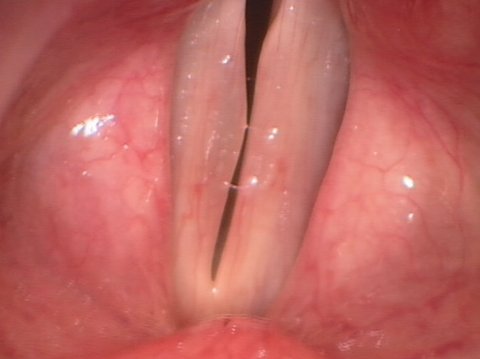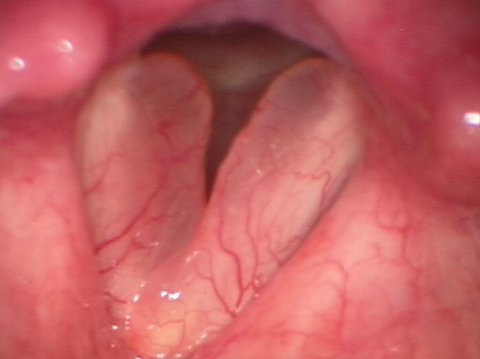What is Reinke’s edema?
Reinke's Edema, also referred to as polypoid corditis, usually manifests as a columnar swelling along the entire length of the vocal fold. In more severe cases of Reinke's edema, the vocal folds have ballooned in size and appear like water-filled cushions.
In extreme forms, the vocal cord edema be so enlarged that it considerably narrows the airways.
In Reinke's edema, a large accumulation of fluid occurs in the soft, gelatinous layer of the superficial lamina propria, or Reinke’s space. This layer is responsible for the delicate rolling of the vocal folds’ mucous membrane and is what produces the tonal beauty of the human voice. Swelling or thickening of this tissue layer can lead to marked changes in voice quality.
Incipient Reinke's edema


How does Reinke’s edema develop?
In over 95% of the cases, Reinke's edema develops from cigarette smoking.
Virtually all patients suffering from vocal cord edema report a strong smoking habit. It is additionally presumed that overuse of the voice is another multifactorial cause.
Interestingly, women over the age of 40 are the most frequent sufferers of Reinke's edema.
Hormonal factors have likewise been discussed in connection with the pathogenesis of this disease.
Progression of Reinke's edema


What symptoms does Reinke’s edema cause?
- Deep, rough voice
- Limited ability to modulate voice
- Rapid vocal fatigue
- Impairment of breathing (shortness of breath, noisy breathing)
Patients with Reinke's edema primarily complain about a deep, rough voice, a limited ability to modulate their intensity and quality of voice along with rapid vocal fatigue. Female patients often report that they are taken for a man on the telephone. More lengthy periods of speaking cost them exceptional effort.
Once the vocal cord edema has exceeded a certain volume, breathing may also be compromised. The patients complain about a shortness of breath and sometimes abnormal noises when breathing in. When Reinke's edema is particularly severe, the breathing impairment can reach a significant level.

What treatment options are available for Polypoid Corditis?
An overview of treatment options:
- Voice therapy
- Voice surgery
These have no effect on the clinical picture:
- Pharmacotherapy
- Inhalation
In the early stages, the voice changes associated with Reinke's edema can frequently be compensated for by intensive voice therapy.
In moderately and highly severe forms, voice surgery is almost always the therapy of choice. The phonosurgical procedure to treat Reinke's edema (Polypoid Corditis) is described in detail in the section Voice Surgery for Reinke's Edema. Moreover, patients are urged to significantly limit their smoking or, at best, to stop altogether. Even after successful surgery, Reinke's edema will come back with continued smoking.
Drugs, like diuretics will not lead to any desired reduction in the volume of vocal cord edema. Because a disease of the subepithelial space is involved, in other words, a tissue layer underneath the superficial layer of the vocal cord, decongestant inhalation will not have the desired effect either.
Example of phonosurgical treatment for Reinke’s edema
Reinke's edema before surgery
Reinke's edema after surgery

Truths and Myths About Reinke’s Edema
Fundamentally, Reinke's Edema is not a precancerous lesion, in other words, it does not involve an early stage of laryngeal cancer. Since Reinke's edema almost only occurs in strong smokers, those individuals should be aware that vocal fold cancer could develop independently of Reinke's edema.
Smoking is known to be the most common trigger of laryngeal cancer. Therefore, patients with Reinke's edema should get regular cancer screening examinations by a specialist, especially since the voice quality strongly affected by Reinke's edema can mask the development of laryngeal cancer.

Case Report: Reinke’s Edema (Polypoid Corditis)
A 48-year-old woman insurance agent had been increasingly noticing voice complaints for several years. Her voice was hoarse and deep; she reported frequently being taken for a man on the telephone; in general, her voice would fatigue faster than several years ago.
The woman had been a heavy smoker since a young age, smoking 20-30 cigarettes daily. In the previous six months, breathing impairments occurred in addition to her voice disorder. The woman particularly complained of shortness of breath during physical exertion, most notably when climbing stairs.
The videostroboscopic examination by the ENT specialist showed strikingly severe Reinke's edema on both sides, with the edema of the right vocal cord being more excessive than on the left. The vocal fold vibrations were markedly interrupted, the voice quality hoarse, the average speaking pitch markedly lowered.
Her singing voice had essentially disappeared.
The patient was recommended to submit herself to a phonosurgical procedure. In a single session, both vocal folds were successfully operated on. After two weeks of voice rest, both vocal folds were of nearly exactly the same size and vibrated symmetrically, achieving complete closure during phonation. Her vocal quality was now strong and clear; her average speaking pitch was raised by a third octave. This patient perceived her own voice as pleasant, having a much fresher tone and sounding 15 years younger than before surgery.
She had meanwhile reduced her smoking down to ten cigarettes a day and planned to quit completely within the next six months.




